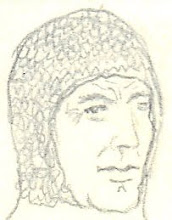As a lad I was a self-taught casual wargamer. Like many boys, my oldest friend Steve H. and I had cheapo plastic GIs; but an increasing interest in the Second World War around the age of ten led to my acquisition of historically-accurate HO-scale plastic soldiers (mostly Airfix) and ordnance. I knew of H.G. Wells' Little Wars but never saw a copy and didn't learn the details. With Roddy F., a friend I made at age 12, I conducted an alternate-reality simulation of the war, complete with plans, reports, and maps as though we were personally directing the Wehrmacht. Battle outcomes were the culmination of hits and misses based on eyeball estimations; it did not occur to us to quantify data or to use dice or other randomizers. Casualties were pro-rated according to the ratio of toy soldiers and equipment fighting in a representative battle at the tactical level to the forces that were participating at the strategic level. We lost interest during the German invasion of the British Isles (invasion areas were Cork, Inverness, and Plymouth). At around the same time, my grandfather (one of the youngest RAF pilots of the Second World War) gave me the 1977 edition of Avalon Hill's venerable D-Day wargame, which used a hexagonal gridmap, dice, and combat tables.
Years earlier, Steve H. and I made up a kind of paper wargame. We drew floorplans of castles and garrisoned them with symbols representing crossbowmen and other defenders. We then added attacking troops and played out a siege by redrawing forces in their new positions after each combat exchange. Ranged attacks were resolved by "skating" a pencil tip along the desired trajectory by means of an index finger precariously placed on the pencil's other end. Even if we had thought of applying dice and mathematics, Dungeons & Dragons had already beaten us to the market.
Dungeons & Dragons
My first real exposure to Dungeons & Dragons was in 1979 or '80. A Toronto hotel was hosting some kind of expo for smart, creative kids, and I was offered the chance to attend by my avant-garde grade 7 teacher. I was accompanied by Arthur D., a friend and classmate with whom I had made a stop-motion Super 8 animated short depicting a space battle. In one small room or partitioned area of the hotel convention area, a group of older teenaged boys were gathered around a table covered with graph paper, books, and dice. I was vaguely aware that Dungeons & Dragons, which was only about five or six years old at the time, involved bearded gnomes, caverns, and treasure chests. The game seemed whimsical at a time when I was more interested in warfare and the horror genre, so I made no attempt to learn how it was played.
In 1981, Nick P., another friend and classmate, received the Tom Moldvay version of the Dungeons & Dragons Basic Set for Christmas. We didn't know how to play, so I spent an hour or so excitedly poring over the rulebook. It was a revelation and the beginning of a decades-long obsession with role-playing games. Soon I had recruited my friends Steve and Roddy, and the three of us would play Advanced D&D regularly on weekends for the five years that remained before adulthood started interfering. We took turns DMing each other in four-session rotations, using and abusing Tolkien's Third-Age Middle Earth as a common setting until we each created our own worlds. Other friends gravitated towards our "Sunday Group". A few of us played other games on occasion, such as Call of Cthulhu, Top Secret, Car Wars, and Paranoia. Around 1988-89, Ed Greenwood himself DM'd some friends and me in his intricate Forgotten Realms campaign setting, which we played on Saturday mornings in the undercroft of Brookbanks Public Library in Toronto, where he worked.
Cells & Serpents
We had our own house rules, of course (nobody played straight AD&D, Gary Gygax included), but my dissatisfaction with certain D&D game mechanics led me to design my own game. I created Cells & Serpents around 1988. Taking a cue from pre-d20 Chaosium, the base mechanic was a d100 roll, from which I created a unique combat system with elements borrowed from GURPS, Top Secret/SI, and good old D&D. The Rolemaster Character Law skill system was grafted on, and the magic system was based on Rolemaster's Spell Law. This worked well for the time I used it, probably until around 1997. By this time we were playing only sporadically. Roddy had moved away, Steve was spending more time playing with another group, and much of my free time was soon to be devoted to my new purchase, a 1998 Chevrolet Camaro SS. I went on de facto hiatus as DM, but continued as a player while other friends stepped behind the DM screen.
Mailed Fist
The excellent Ars Magica game, which I read around 1994, inspired me to rethink Cells & Serpents. My system contained D&D remnants that compromised playability, such as numerical scores for abilities like strength and dexterity that were meaningless in themselves but which had to be translated into the numbers that were actually used in the game; Ars Magica avoided this middleman and expressed ability scores as direct values. Both Ars Magica and Dungeons & Dragons 3rd edition (and later) employed an elegant base mechanic: for an action to succeed, a die roll + any relevant modifiers must match or exceed a target number that represents the action's difficulty.
I dropped the name Cells & Serpents when an Internet search revealed that it already belonged to a computer game. The new game was dubbed Mailed Fist. As of this writing, most of the heavy design work is complete.
Next: "Diary of a


No comments:
Post a Comment